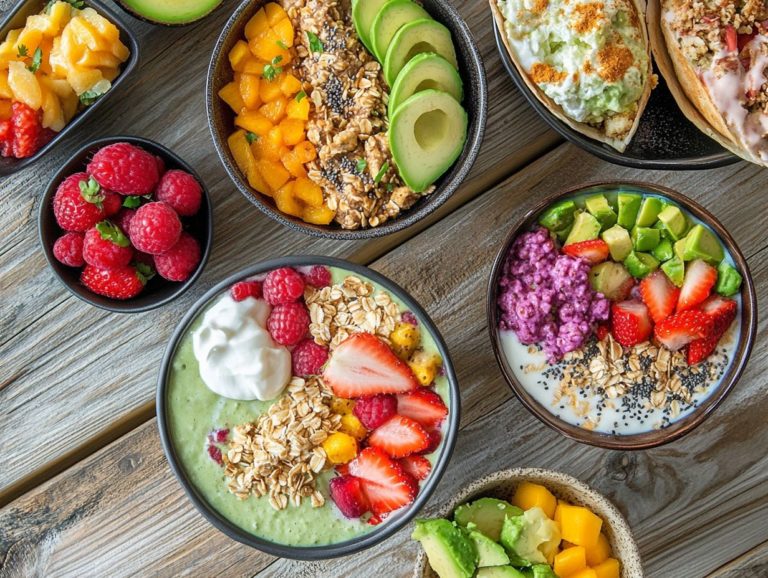Paleo Diet Essentials: What You Need to Know
Get ready to discover all the exciting details about the Paleo Diet! This article reveals everything you need to know about this popular eating plan inspired by our ancient ancestors.
It explores the origins and core principles of the diet, delving into the numerous health benefits it offers while providing practical tips for effectively following it.
You ll also find a discussion on potential risks, including nutritional deficiencies, along with strategies for success ranging from meal planning to managing cravings.
Prepare to explore whether the Paleo lifestyle aligns with your personal health goals!
Contents
Key Takeaways:

- The Paleo diet is based on the principles of our ancestors and focuses on whole, unprocessed foods.
- Benefits of following the Paleo diet include improved health and well-being, increased energy, and weight loss.
- To follow the Paleo diet, focus on consuming lean proteins, vegetables, fruits, nuts, and seeds while limiting processed and refined foods.
What is the Paleo Diet?
The Paleo Diet invites you to embrace a way of eating reminiscent of our ancestors, urging you to indulge in whole foods that are minimally processed and brimming with nutrients.
This diet emphasizes the enjoyment of lean meats, fresh fruits, and vibrant vegetables while steering clear of modern processed foods, grains, and dairy products.
By following guidelines inspired by the eating habits of hunter-gatherers, you can enhance your overall health and effectively manage your weight.
Origins and Principles of the Diet
The Paleo Diet draws its roots from the dietary habits of your hunter-gatherer ancestors, who thrived on a bounty of whole foods like lean meats, fruits, and vegetables. This approach mirrors the natural eating patterns that sustained early humans, focusing on unprocessed foods that are free from additives and artificial ingredients.
By embracing these ancestral dietary choices, you align with the biological and evolutionary patterns embedded in your genes. The principles guiding this diet emphasize eliminating refined sugars, grains, and dairy, while prioritizing nutrient-rich options that promote your overall health.
Modern adaptations of the Paleo Diet often weave in nutrition guidelines to ensure you maintain a balanced intake of essential vitamins and minerals, effectively bridging the gap between ancient wisdom and contemporary nutritional science.
Benefits of the Paleo Diet
The Paleo Diet presents a wealth of health benefits, making it an enticing option for anyone seeking weight loss, enhanced energy levels, and a lower risk of chronic conditions such as obesity and heart disease.
Improvements in Health and Well-being

Following the Paleo Diet can lead to substantial improvements in your health and well-being, thanks to its focus on nutritious, whole foods while cutting out harmful processed options.
You may find that many individuals have experienced remarkable transformations in their weight and energy levels since embracing this lifestyle. For instance, one person shared how eliminating refined sugars and grains helped her shed 20 pounds in just a few months, leaving her feeling lighter and more energetic throughout the day.
Many also notice improvements in digestion and skin clarity, with numerous individuals attributing these health benefits to the diet s emphasis on lean meats, fish, vegetables, and healthy fats. The diet not only promotes weight loss by encouraging the consumption of satiating, nutrient-rich foods but also inspires mindfulness in eating habits.
By prioritizing these wholesome foods, you cultivate a more positive relationship with food overall, ultimately paving the way for lasting changes in your health.
How to Follow the Paleo Diet
To successfully embrace the Paleo Diet, concentrate on creating a meal plan that features a delightful variety of recommended foods. Think lean meats, vibrant fresh fruits, and crisp vegetables.
Avoid processed foods and grains to truly honor the essence of this dietary lifestyle.
Recommended Foods and Meal Plans
The Paleo Diet invites you to indulge in a diverse array of whole foods, including lean proteins, vibrant fruits, crisp vegetables, nuts, and healthy fats like olive oil. This approach champions the benefits of grass-fed meats, free-range poultry, and wild-caught fish, all brimming with omega-3 fatty acids and essential nutrients.
Imagine filling your plate with healthy vegetables such as kale, sweet potatoes, and broccoli. These options offer a wealth of vitamins and minerals. Complement this with fruits like berries, apples, and bananas that not only add a delightful natural sweetness but also deliver a dose of antioxidants.
For a meal that tantalizes the taste buds, consider preparing a succulent grilled salmon accompanied by roasted Brussels sprouts and a refreshing mixed greens salad topped with creamy avocado. Alternatively, whip up a hearty beef stir-fry showcasing a vibrant medley of bell peppers and zucchini. This illustrates just how varied and satisfying a Paleo meal plan can truly be.
Potential Risks and Considerations
While the Paleo Diet offers a range of benefits, it’s crucial to keep in mind the potential risks, particularly the likelihood of nutritional deficiencies.
One key concern is calcium deficiency, which may arise from eliminating dairy products from your diet.
Addressing Nutritional Deficiencies

Addressing nutritional deficiencies while adhering to the Paleo Diet requires careful planning and ideally a consultation with a dietitian to ensure you re getting enough essential nutrients like calcium.
This process involves recognizing foods that align with Paleo principles while being mindful of those rich in vital vitamins and minerals. Whole foods think leafy greens, nuts, seeds, and fatty fish should be the bedrock of your diet, offering a comprehensive range of nutrients without the additives commonly found in processed options.
Consider adding supplements to fill any gaps and boost your energy, particularly for nutrients like vitamin D or omega-3 fatty acids. Collaborating with a professional can help you craft a personalized approach that meets your individual needs, paving the way for better health and well-being.
Tips for Success on the Paleo Diet
To truly succeed on the Paleo Diet, you must commit to the recommended food choices while integrating regular exercise and implementing effective strategies to manage cravings for processed foods.
This holistic approach will elevate your experience and results, allowing you to thrive on this journey toward better health.
Incorporating Exercise and Managing Cravings
Incorporating exercise into your routine is crucial for reaping the full benefits of the Paleo Diet and managing cravings for unhealthy foods.
Engaging in a variety of physical activities like strength training, high-intensity interval training (HIIT) (a workout strategy that alternates intense bursts of activity with rest periods), or even outdoor adventures such as hiking or cycling can significantly boost your body s metabolic response to the nutrients you consume. This holistic approach supports muscle development and overall fitness, while also helping regulate your appetite, making it easier to resist the temptation of processed snacks.
Embracing mindfulness practices, like keeping a food diary or dedicating time to regular meal preparation, empowers you with greater control over your cravings. By prioritizing a balance of wholesome foods rich in proteins, healthy fats, and seasonal vegetables you ensure your body receives essential nutrients while fostering a sustainable lifestyle that aligns beautifully with the principles of the diet.
Frequently Asked Questions
What is the Paleo Diet?

The Paleo Diet is a way of eating that focuses on consuming whole, unprocessed foods that our ancestors would have eaten during the Paleolithic era. This includes lean meats, fruits, vegetables, nuts, and seeds.
What will your first Paleo meal be?
What are the benefits of following the Paleo Diet?
Discover the exciting benefits of the Paleo Diet! You may experience weight loss, improved digestion, and increased energy levels.
This diet can also help with better blood sugar control and reduced inflammation in the body.
What foods are not allowed on the Paleo Diet?
The Paleo Diet excludes processed foods, dairy products, grains, legumes, and added sugars. This means no bread, pasta, rice, cheese, beans, or desserts.
It also excludes most packaged and convenience foods, helping you focus on healthier options.
Can I still eat carbohydrates on the Paleo Diet?
Yes, but in moderation! The Paleo Diet encourages consuming carbs from natural foods like fruits and vegetables.
It excludes processed carbs that are stripped of fiber, such as white bread and sugary snacks.
Do I need to take supplements on the Paleo Diet?
The Paleo Diet emphasizes whole foods that are rich in nutrients, so supplements are not necessary for most people.
However, if you have specific nutrient deficiencies or health concerns, consult with a healthcare professional before starting any new diet.
Is the Paleo Diet safe for everyone?
The Paleo Diet may not be suitable for everyone, especially those with medical conditions requiring specific dietary restrictions.
It’s important to consult with a healthcare professional to ensure it is safe and appropriate for you.
Ready to learn more about the Paleo Diet? Explore additional resources or consult a professional for personalized advice!






